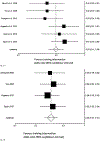Team Approach: Neuromuscular Training for Primary and Secondary Prevention of Anterior Cruciate Ligament Injury
- PMID: 38994007
- PMCID: PMC11236273
- DOI: 10.2106/jbjs.rvw.23.00207
Team Approach: Neuromuscular Training for Primary and Secondary Prevention of Anterior Cruciate Ligament Injury
Abstract
Neuromuscular training is a method of performance optimization-typically combining plyometrics, balancing training, agility, and dynamic stabilization-predicated on improving the efficiency of fundamental movement patterns. Neuromuscular training has consistently been shown to reduce the risk of anterior cruciate ligament injury, particularly for athletes engaged in activities associated with noncontact knee injuries (i.e., women's soccer). Successful implementation of neuromuscular training programs requires input from coaches, physical therapists, athletic trainers, and physicians to generate efficacious programs with high rates of adherence.
Conflict of interest statement
Disclosure: The Disclosure of Potential Conflicts of Interest forms are provided with the online version of the article (http://links.lww.com/JBJSREV/B68).
Figures



References
-
- Kaeding CC, Léger-St-Jean B, Magnussen RA. Epidemiology and diagnosis of anterior cruciate ligament injuries. Clin Sports Med. 2017;36(1):1–8. - PubMed
-
- Gornitzky AL, Lott A, Yellin JL, Fabricant PD, Lawrence JT, Ganley TJ. Sport-specific yearly risk and incidence of anterior cruciate ligament tears in high school athletes: a systematic review and meta-analysis. Am J Sports Med. 2016;44(10):2716–23. - PubMed
Publication types
MeSH terms
Grants and funding
LinkOut - more resources
Full Text Sources

